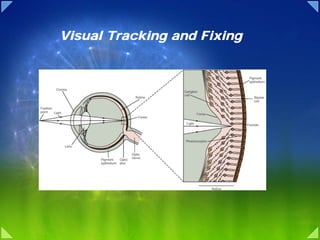
Visual Tracking and Fixing: How the Eyes Stabilize Images
- 1. Visual Tracking and Fixing
- 2. Visual Tracking • Why Visual Tracking ? – To keep the image in the Fovea which is less than 1mm size and detect visual field of less than diameter of full moon. – It keeps the eye still when the image is still and stabilizes the image when the object moves in the world or when the head itself moves. • How Visual Tracking? – Oculomotor system: moves the eye in the orbit – Head movement which moves the orbit in the space – Information of head motion processed by the vestibular system
- 3. Three Axes of Eye Rotations 1. Ductions refer to monocular movements of each eye 2. Versions refer to binocular conjugate movements of both eyes 3. Vergences refer to binocular disjunctive movements
- 5. Extra-ocular muscles nerve supply
- 6. Actions of Extra-ocular muscles
- 7. Laws of Ocular Motor Control 1. Sherrington's law of reciprocal innervation 2. Hering's law of equal innervation
- 9. "Visual Accessing Cues" Richard Bandler and John Grinder "Frogs into Princes: Neuro Linguistic Programming (NLP) "
- 10. Up and to the Left Indicates: Visually Constructed Images (Vc) If you asked someone to "Imagine a purple buffalo", this would be the direction their eyes moved in while thinking about the question as they "Visually Constructed" a purple buffalo in their mind.
- 11. Up and to the Right indicates: Visually Remembered Images (Vr) If you asked someone to "What color was the first house you lived in?", this would be the direction their eyes moved in while thinking about the question as they "Visually Remembered" the color of their childhood home.
- 12. To the Left Indicates: Auditory Constructed (Ac) If you asked someone to "Try and create the highest the sound of the pitch possible in your head", this would be the direction their eyes moved in while thinking about the question as they "Auditorily Constructed" this this sound that they have never heard of.
- 13. To the Right Indicates: Auditory Remembered (Ar) If you asked someone to "Remember what their mother's voice sounds like ", this would be the direction their eyes moved in while thinking about the question as they "Auditorily Remembered " this sound.
- 14. Down and to the Left Indicates: Feeling / Kinesthetic (F) If you asked someone to "Can you remember the smell of a campfire? ", this would be the direction their eyes moved in while thinking about the question as they used recalled a smell, feeling, or taste.
- 15. Down and To the Right Indicates: Internal Dialog (Ai) This is the direction of someone eyes as they "talk to themselves".
- 16. Brain area participate in Visual Fixation The cerebral structures involved in fixation are: Parietal eye field (lateral interparietal area and area 7a in monkeys) V5 and V5A (MT and MST in monkeys) Supplementary eye field Dorsolateral prefrontal cortex The brainstem structures involved in fixation are: Substantia nigra pars reticulata in the basal ganglia Rostral pole of the superior colliculus
- 17. An Active Fixation System Keeps the Eyes on a Stationary Target
- 18. The Visual Fixation System •The fixation system holds the image of a stationary object on the fovea when the head is immobile. •Steady fixation is actually an illusion. •Normal fixation consists of three distinct types of physiological miniature movements that are not detectable by the naked eye
- 19. Eye Movement Function of Eye Type of Eye Movement Movement "Version" (Conjugate) "Vergence" (Disjunctive) "Holding" (slow) •Smooth Pursuit •Optokinetic Nystagmus •Convergence (slow phase) •Divergence •Vestibular Nystagmus •Accommodative Vergence "Catching" (fast) •Saccades •Optokinetic Nystagmus (quick phase) "Sustaining" (miniature) •Microsaccades •Tremor •Drift voluntary eye movement; involuntary eye movement
- 20. The Vestibular and Optokinetic Systems • The vestibulo-ocular and optokinetic reflexes are the earliest eye movements to appear phylogenetically • The vestibulo-ocular reflex (VOR) stabilizes retinal images during head motion by counter-rotating the eyes at the same speed as the head but in the opposite direction • Optokinetic eye movements stabilize the eyes during tracking of a large moving visual scene, which causes an illusionary sensation of self rotation (circularvection) in the opposite direction
- 21. Types of Head Motion 1. Rotation : A change in orientation 2. Translation: A change in position
- 22. Characteristics of the VOR The VOR stabilizes retinal images during brief head movements by counter-rotating the eyes at the same speed as the head but in the opposite direction
- 23. The Horizontal VOR Pathway
- 24. The Vertical and Torsional VOR Pathway
- 26. VOR Adaptation and the Cerebellum
- 27. The Optokinetic System •Optokinetic nystagmus is induced reflexively by motion of a large visual scene, which causes an illusionary sensation of self- rotation (circularvection) in the opposite direction •Whereas the angular VOR responds best to brief, high- frequency head rotation, the optokinetic system maintains retinal image stability during sustained, low-frequency rotation
- 28. The Saccadic System Points the Fovea Toward Objects of Interest
- 30. Pulse-Step of Innervation for Saccadic Eye Movement
- 31. Extraocular Motor Signal Eye Position and Velocity
- 32. Central control of Horizontal Saccad
- 33. Brainstem Generation of Vertical and Torsional Saccades
- 34. Cortical Pathway for Saccades
- 35. Summary of Central Control of Saccades
- 36. The Smooth Pursuit System Keeps Moving Targets on the Fovea
- 37. Gaze Involves Combined Head and Eye Movements
- 38. Cortical control of Pursuit Eye movement
- 39. Summary of Central Control of Pursuit Eye Movement
- 41. Neural Substrate of Vergence Eye Movements
- 42. Thank You
